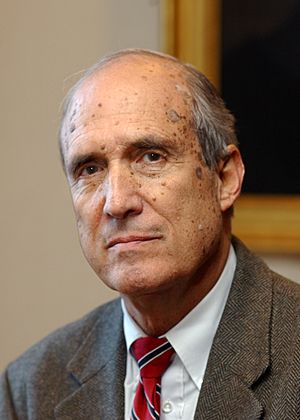Robert Berner facts for kids
Quick facts for kids
Robert Berner
|
|
|---|---|
 |
|
| Born |
Robert Arbuckle Berner
November 25, 1935 |
| Died | January 10, 2015 (aged 79) New Haven, Connecticut
|
| Nationality | American |
| Alma mater |
|
| Known for |
|
| Awards |
|
| Scientific career | |
| Fields |
|
| Institutions | |
| Notable students | Donald Canfield |
Robert Arbuckle Berner (November 25, 1935 – January 10, 2015) was an American scientist. He was famous for helping us understand the carbon cycle. This is how carbon moves around Earth's atmosphere, oceans, and rocks. He taught Geology and Geophysics at Yale University for many years. His work helped create important models like the BLAG model. This model helps scientists figure out how much carbon dioxide was in the air long, long ago.
Contents
Robert Berner: Earth's Carbon Detective
Early Life and Education
Robert Berner was born on November 25, 1935, in Erie, Pennsylvania. His older brother, Paul, who was also a geologist, encouraged his interest in Earth science. Robert first went to Purdue University. He then moved to the University of Michigan, where he earned his first two degrees. He got his bachelor's degree in 1958 and his master's degree in 1959. After that, he went to Harvard University. There, he earned his PhD in Geology in 1962.
Studying Earth's Past Climate
In 1962, Robert Berner received a special award to do research. He worked at the Scripps Institution of Oceanography in San Diego, California. From 1963 to 1965, he was a professor at the University of Chicago. Then, in 1965, he started teaching at Yale University. He became a very important professor there and taught until he retired in 2007.
Berner's early studies looked at how chemicals react in sedimentary rocks. These are rocks formed from layers of sand, mud, and other materials. His findings led to his 1971 book, Principles of Chemical Sedimentology. In 1980, he wrote another important book, Early Diagenesis: A Theoretical Approach. This book was used so much that it became a "Science Citation Classic." This means it was one of the most important and often-used books in science.
Understanding the Carbon Cycle
Robert Berner noticed how sedimentary rocks play a big part in the carbon cycle. The carbon cycle describes how carbon moves between the Earth's atmosphere, oceans, land, and living things. In 1983, Berner, along with Tony Lasaga and Bob Garrels, created the BLAG model. The name BLAG comes from the first letters of their last names. This model helps scientists guess how much carbon dioxide was in the air way back in time. It looks at how both Earth's geology and living things affect carbon.
Berner later made an even bigger model called GEOCARB. This model helps scientists understand carbon dioxide levels even further back in Earth's history. His later work used computers to study the carbon and sulfur cycles. He also looked at how carbon dioxide and oxygen in the air affected Earth's climate in the past, known as paleoclimate.
Family Life
In 1959, Robert Berner married Elizabeth Marshall Kay. She was also studying geology. They had three children together. In 1995, they even wrote a book together called Global Environment: Water, Air, and Geochemical Cycles. Robert's father-in-law, Professor Marshall Kay, was also a famous geologist.
Robert Berner passed away on January 10, 2015, after being sick for a long time.
Awards and Recognition
- Member of the National Academy of Sciences
- Most-cited Scientist, Institute for Science Information
- Sverdrup Postdoctoral Fellow, Scripps Institute of Oceanography, 1962-1963
- Alfred P. Sloan Research Fellowship in Chemistry, Alfred P. Sloan Foundation, 1968
- Mineralogical Society of America Award, 1971
- Guggenheim Fellow in Earth Science, John Simon Guggenheim Memorial Foundation, 1972
- Doctor Honoris Causa, Université Aix-Marseille III, 1991
- A.G. Huntsman Award for Excellence in the Marine Sciences, 1993
- V. M. Goldschmidt Medal, The Geochemical Society, 1995
- Murchison Medal, Geological Society of London, 1996
- Arthur L. Day Medal, Geological Society of America, 1996
- Bownocker Medal, Ohio State University 2001
- Vernadsky Medal, International Association of GeoChemistry, 2012
- Benjamin Franklin Medal in Earth and Environmental Science, Franklin Institute, 2013

